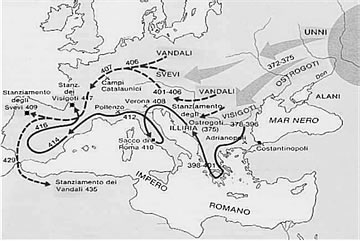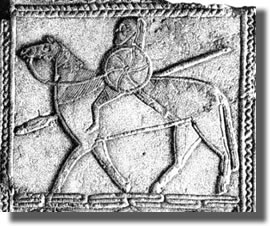Scientific Area » Longobard Culture » Great Migrations and Ethnogenesis
« Back
GREAT MIGRATIONS AND ETHNOGENESIS
The ethnogenesis process which concerned the Longobards in the first stage of their migration was confirmed by the deeds of the Goths, in particular of those tribal groups who went under the name of Visigoths, first under the guidance of Alaric (late IV - early V century), who tried to invade Italy but with scarce success. After migrating from the Danube and Balkan area to the West, they settled first in Acquitaine and then, at the wave of the increasing Frankish power, in the Iberian Peninsula, where Alaric founded their kingdom (6th – early 8th century).

A longer-lasting settlement was experienced by the Merovingians, the ancestors of the Franks, who strengthened their power in Central Western Europe (present-day France), giving rise to a Kingdom which relied upon a strong alliance with Catholic Bishops and the Senators survived to the Collapse of the Empire (476). The strength of the Merovingians took shape through the mass conversion to Catholicism in 506 under the model guidance of king Clovis. The way was paved for the future Christian empire of Charlemagne which aspired to become universal and turned to a National state, thus laying the foundations of modern states.
Quite different was the migration of a nomadic people of Mongolian origin, the Huns: indeed their impressive military conquest - an aspect marking any migration of peoples – was not followed by the building up of a form of state ruling the invaded lands, mainly because the strength of the Hun empire built on a scarcely cohesive military force made up of an aggregate of traditional groups.
Other steppe peoples such as the Avars – whose migration coincided with the arrival of the Longobards in Italy - or the Hungarians – who took part in the Great Migrations during the Middle Ages - managed to build up steady kingdoms out of nomadic tribes. In particular the Hungarians laid the foundations of a modern nation.
The migration of the Longobards is thus included in a widespread process of universal value which does not purport to be used in diachronic comparisons but rather, in view of the final land of settlement, to recall the Norman invasion of Southern Italy in full Middle Ages, since both peoples had in common both military capability and a strong sense of social hierarchy.

The aforesaid migrations of peoples altered the ancient structures of power in different geographical areas. Whereas in the West they laid the foundations for the building up of modern states, in the Middle East and Northern Africa the Arab conquest gave rise to new empires and a new system of territorial powers.
Although widely separated, the progressive migration either with evident thirst for conquest over the early centuries of the modern era by Hispanic and Portuguese peoples under the guidance of powerful and noble adventurers to Latin America, or out of necessity by Anglo-Saxon loose groups to the present-day United States of America caused the foundation of new societies and territorial states with new organized structures of power.
The migrations of peoples have been and are currently a primary vehicle in the building of innovative cultures, because these latter stem from different contributions and matrices merging together but still deeply rooted in a variety of previous traditions – refined if referred to the Roman Byzantine or the Persian- Sassanid worlds in the Middle east or to the Spanish world in the Latin American dominations. Transfers of power and cultural acquisitions which have ever been the primary means to renewal and the transmission of universal values belonging to art, architecture and other expressions of ancient and modern societies from the Mediterranean and other areas.
« Back


